Class 104 BRC&W 2, 3 & 4-car DMUs
Operations - Early Days
The first four sets were delivered in April (two sets) and May 57 (two sets) to Longsight, the first of two batches of 3-car sets for the LMR.
An early sighting was 50420/59132/50424, with B1 on the route indicator, working from Longsight on the 20th April 1957.
Noted at Longsight on the 19th May 1957 were 50421/59133/50425 and 50423/59135/50427.
They entered service on the Buxton line on the 17th June 1957, along with other blue square types. They replaced the Derby Lightweights (introduced to the line on 8 October 1956) which could not cope with the demanding gradients and conditions of the 'Spa Line'.
The second batch of 52 sets would also be delivered in 1957.
Noted working the Manchester - Buxton - Crewe services on the 17th June 1957 were 50423/59135/50427, 50428/59136/50480, 50430/59138/50482 and 50431/59139/50483.
Crewe - Stoke - Derby Midland
On Monday 16th September 1957 sets were introduced on an improved service between Crewe and Derby via Stoke. There were some half dozen more trains in each direction on weekdays, and three more on Sundays. Timings were based on an even-timed hourly service on weekdays and two-hourly on Sundays, with timings cut by some 27 mins compared with previous steam schedules. The 51 miles, stopping at all stations, was covered in 87 mins.
A folded leaflet was made available to the public promoting the new trains:
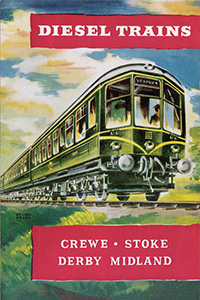
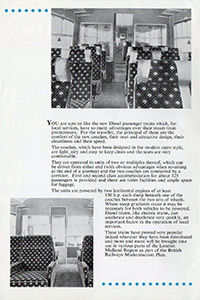
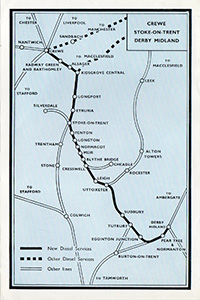
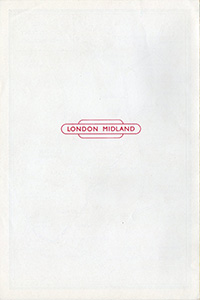
Noted in use in the first days were 50435/59143/50487 and 50428/59136/50480. The only criticism they got was the noisy vibration of the luggage racks when in low gear.
At the same time a new fast diesel service was introduced to Llandudno. The journey from Chester took one hour, and was advertised as being the fastest timing ever to operate between those points. The service was also advertised locally under the name 'The Diesel Rapide'. It left Crewe at 11:15, all stations to Chester, then leaving at 11:55 for Prestatyn (26 mins), Rhyl, Colwyn Bay (46 mins), Llan. Jct & Llandudno. It returned on the previously steam 13:45 through to Derby, to greatly accelerated timings. On the first day it was worked by 50480/59136/50248. Not having Llandudno on the indicators, they simply carried a 'B', arriving exactly on time. It was packed leaving Crewe, with standing in the van, and a steam relief had to be provided to cope with the Chester passengers. The service was scheduled for 2x3-car sets, but Crewe was short of stock.
DMUs had worked the Sunday service on the Millers Dale - Buxton branch for some months before taking over the weekday operations on the 7th October 1957.
On a Sunday excursion working from Manchester to Newcastle on the 3rd November 1957 were 50449/59157/50501 & 50437/59145/50489.

The image shows a three-car set in Birmingham New Street beside a Derby Lightweight on December 16, 1957. M50458 at the front was just a few weeks old and allocated to 5D (Stoke). Michael Mensing.
The Manchester - Hayfield/Macclesfield services saw 198,303 passengers for a sample month in 1957, compared with 136,768 for the same month in 1956, an increase of 61,535. On the Crewe - Stoke - Derby service for the 1957 sample month there were 84,248 passengers were compared with 60,154 in 1956, an increase of 24,094.
The through DMU working on Sundays from Stoke (dep. 16:00) to Rugby (arr 18:38 and return 18:50) was worked by 3-car sets, and on the 26th January 1958 it was the turn of 50437/59145/50489.
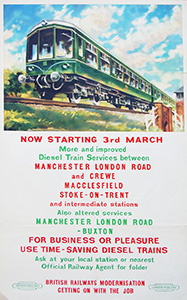
This was a poster used to advertise the 3rd March 1958 enhanced services, scan courtesy of John Paton. John is predominately a collector of Scottish Region publicity material and is willing to swap this poster for ScR material. Get in touch if you are interested.
Extension and problems
At the end of January 1958 the LMR preliminarily announced an extension of DMU services from Manchester (London Rd) to take in Stoke, with an hourly service between the two centres. The new workings were due to begin on the 3rd Feb., but were called off due to a mechanical fault found with the Class 104 bogies, just 48 hours before they were due to begin. Forty-nine sets were taken out of service, and the remedial work was expected to take five weeks and it was hoped the new services would begin in early March. Met-Camm sets were borrowed from the NER, and ten 2-6-4s obtained from Willesden.
They did start on the 3rd March 1958. It made it possible to travel from Wolverhampton (High Level) at 09:06 and 18:23 to Birmingham New Street., via Bescot and Aston by trains which stopped at all stations, although there was not a similar service in the opposite direction.
Buxton Depot
The first four 3-car sets were re-allocated to the then new Buxton diesel depot on Feb 3, 1958 from Longsight, with more sets yet to come. The Class 104s worked the Buxton line for almost 32 years, 31 years of which Buxton constantly had its own allocation of 104s. Buxton allocated driving cars were instantly recognisable with their painted white cab roofs, which complemented the green (and later blue) livery well.
In mid-1958 the Birmingham - Leicester services were worked by 3-car 104s such as 50478 / 59186 / 50530 & Class 105s. On the 1/6/58 an Amateur Photographers excursion from Nottingham, Mansfield and Derby ran to Betws-y-Coed. It was formed of a 9-car set, six from Nottingham (Midland) - 50531 / 59187 / 50479 and Class 105 50754 / 59309 / 50787, and from Mansfield 50478 / 59186 / 50530. The train left Derby (Midland) at 08:40, arriving Betws-y-Coed at 12:10. It returned at 17:00, getting to Derby at 19:55, seven minutes late due to a dead stand at Crewe.
More Deliveries
Mid-1958 saw 15 power-trailer sets delivered, 10 to the LMR at Stoke and 5 to the ER & NER at Bradford.
1958 also saw the 4-car sets delivered, a batch of 21 and a batch of 5, both to the NER, the first ones going to Darlington.
On 23/3/58 an excursion ran from Tyldesley to Scarborough, the train, W590 was comprised of 50483 / 59139 / 50431 & 50482 / 59138 / 50430.

On Good Friday '58 another excursion from Tyldesley to Scarborough had 50501 / 59157/ 50449 & 50502 / 59158 / 50450, but the train failed near Rillington. A Newcastle - Scarborough excursion formed of an 8-car 101 was running behind, and it was decided to couple the two trains together and proceed the 16 1/2 miles to Scarborough, with one driver in the first driving compartment to control the brakes and another driver in the cab of the 7th vehicle (the first of the Newcastle set) to control power. This would not work well, and so it was decided to transfer the passengers from the Tyldesley to the Newcastle set and leave the 104 out of the way on the Whitby branch. The 101 arrived at Scarborough about 80 mins late, making the Tyldesley passengers over two hours late. In the meantime diesel fitters were summoned from York and brought to Scarborough by taxi, only to find the cars were at Rillington after all and they had to retrace their steps for the 16 1/2 miles. The 104s finally arrived at Scarborough at 18:50, just in time for it's booked return at 18:55, but this was put back an hour or so to compensate for the passengers late arrival.
On Easter Sunday 1958 a 104 made it to Scarborough without incident on an excursion from Manchester London Road.
Four-car sets based at Darlington were introduced to York-Harrogate services on the 18th August 1958 to previous steam timings.
Noted at Horwich Works 10/5/59 receiving attention were 50440/492 & 59148.
Allocation Anomalies
When compiling the allocations for the individual vehicles from official sources I come across many anomolies, many of which could be cleared up through further research. There is one concerning two Eastern Region DTC vehicles which needs explanation.
This particular anomaly came to light as 56187 was show as transferred from South Gosforth to 55H on 16/06/68, yet the last recored move was when it went on loan from 51A to 55H in September 1960. So how did it get from 51A to South Gosforth and when? Was I missing an ex-loan move and then a move to South Gosforth? Or did something else happen?
First of all I check that what I entered into the database is correct. And indeed it was, two sources confirming that in September 1960 51A (Darlington) sent Class 101 E50295/56088 and Class 104 E50598/56187 on loan to 55H (Neville Hill). Next thing to check is what happened to E50598 since they would probably have stayed together.
E50598 then went on loan to 31A (Cambridge) in June 1961 and returned ex-loan to 51A in November 1961. But these two moves were shown as being paired with E56189, not E56187, so that didn't explain what happened to E56187. The Class 101 E50295/56088 moved back ex-loan to 51A in November 1960, but there is no mention of E56187 with them then. So next we look deeper into the transfers of the four Class 104 vehicles...
In this era the ER were normally good at keeping sets in original formations. E56187's original partner is E50596. The pair moved together to South Gosforth in October 1959. E50598's original partner was E56189. They were transferred together to South Gosforth in February 1959. All good so far, all four at South Gosforth. The next move was in May 1960 when non-original pair E50598 / E56187 were transferred to 51A. Not too unusual, vehicles did get swapped from time to time due to maintenance / repairs. And this is the pair that went on loan from 51A to 55H on September 1960 mentioned at the start.
E50596 never leaves South Gosforth in the period under examination. It is still listed there with E56187 (back to the original pairing) in 1965. The same 1965 listing shows E50598/56189 (again back to the original pairing) at 51A. The official allocations are:
| 5/59 | 10/59 | 5/60 | 9/60 | 6/61 | 11/61 | 1965 | |||
|---|---|---|---|---|---|---|---|---|---|
| 50596 | at 52J | to 51A | to 52J | at 52J | |||||
| 56187 | at 52J | to 51A | to 52J | to 51A | o/l 55H | at 52J | (no move 55H to 52J) | ||
| 50598 | at 52J | to 51A | o/l 55H | o/l 31A | ex/l 51A | at 51A | |||
| 56189 | at 52J | o/l 31A | ex/l 51A | at 51A | (returned 51A not 52J) | ||||
Looking closer at the move to 31A on loan in 7/61 (original pairing E50598/56189) the DMBS moved 55H to 31A, the DTC moved South Gosforth to 31A. The next move for the pair was 51A ex-loan, yet 56189 had been on loan from South Gosforth. It all points to a mix-up between 56187 and 56189.
My suggestion is that one of two things could have happened. 56187 could have moved in a non-original pairing to 51A in May 1960 and to 55H on loan that September - 56189 could have been out of action. While at 55H 56187 and 56189 were switched when 56189 back to keep the original pairing (if vehicles always worked together their mileage based maintenance always falls at the same time for both vehicles, if vehicles are mixed then they fall at random times meaning lots more choping and changing of formations). But for 50596 not to have been sent with 56187 means it would also have to be out of action, and there transfers of 56187 back to South Gosforth and 56189 to take its place at 51A on loan to 55H would have been recorded. I think this is unlikely to have happened.
What I think did happen is that 56187 WAS NOT transferred to 51A in May 1960, nor on loan to 55H in October 1960. I suggest that it stayed at South Gosforth with its original partner 50596, and that 56189 made those moves with its original partner 50598 instead. As 56187 stays at South Gosforth it is in the correct place for its next move to 55H in 1968, which started this investigation, and explain why there is no ex-loan to 51A and no subsequent move from 51A to South Gosforth. It also explains why 56189 was returned ex-loan from 31A to 51A since it had been tranferred there in May 1960, it was no longer a South Gosforth vehicle. So the allocations would look like this:
| 5/59 | 10/59 | 5/60 | 9/60 | 6/61 | 11/61 | 1965 | |||
|---|---|---|---|---|---|---|---|---|---|
| 50596 | at 52J | to 51A | to 52J | at 52J | |||||
| 56187 | at 52J | to 51A | to 52J | at 52J | (no conflicts) | ||||
| 50598 | at 52J | to 51A | o/l 55H | o/l 31A | ex/l 51A | at 51A | |||
| 56189 | at 52J | to 51A | o/l 55H | o/l 31A | ex/l 51A | at 51A | (returned to correct place) | ||
These are just my thoughts. If you have any ideas or disagreements please let me know!
Summary
Ordering Details
Description
Interiors
Modifications
Single Engine Conversion
2-car diagrams & Works Pics
3-car diagrams & Works Pics
4-car diagrams & Works Pics
Numbering & Drivers Instructions
Liveries
Operations - Early Days
Operations - Later Days
Operations - Scotland
Accidents
Decline
Non-Passenger Use
Images
Details about preserved Class 104s can be found here.
Many thanks to Kevin Dowd for his assistance in the preparation of these pages, and to Eddie Knorn for further data.


